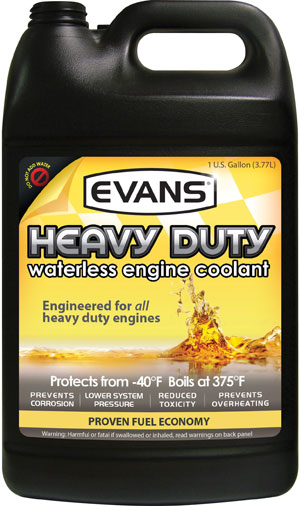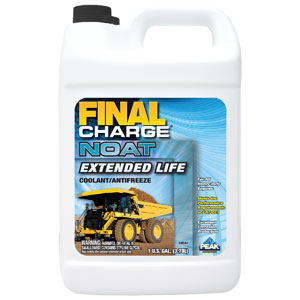ummins’ Hahn, who adds that recent advancements in engine and cooling system technology have resulted in more OEMs moving to a full OAT type coolant.
Coolant makeup
Because of the first and foremost coolant function – efficient heat transfer – almost all coolants contain 40% to 60% water, which is “the most effective heat transfer agent readily available for this number one job,” says Old World’s Pellet. “Where heat transfer is limiting, even higher levels of water may be used.”
Most coolants today also offer freeze protection, which is provided by ethylene glycol. “When mixed with water, glycol can lower the coolant freeze point to -30˚ to -50˚ F with the greatest freeze point depression coming at about 60% glycol content,” Pellet explains. “Glycol is not as efficient at heat transfer as water, so some cooling capability is sacrificed to gain freeze protection.”
The third component is comprised of a corrosion inhibitor package. Corrosion inhibitors must protect all cooling system components, which can include iron, steel, copper, brass and aluminum. “While of great importance, the inhibitor package may comprise only 3% to 5% of the total coolant composition,” Pellet says, adding that coolant also contains minor components such as scale inhibitors, anti-foams, dyes and sometimes bittering agents to reduce chances of accidental ingestion.
Waterless coolant
According to Mike Tourville, director of marketing for Evans Cooling Systems, because of newer engine technologies, a coolant that can transfer heat under extreme environments without forming vapor – and hence pressure – or overheating is a preferable choice. Water loses most of its heat transfer abilities when it turns to vapor, creating stress within the cooling system. A waterless coolant, such as Evans, does not form vapor in an engine because of its high boiling point.

“Water-based coolants are pushed to their limits and the demands of an engine are forcing cooling technologies to raise the bar,” he notes. “One major difference between water-based coolants and Evans waterless coolants is that the bar can safely be raised without worrying about cooling system failure.”
Tourville explains that water’s low boiling point – normally at 212 degrees F, but up to 240 to 250 degress in a pressurized system – becomes the failure temperature of the cooling system. Coolants containing 50% water (most coolant is a 50/50 mix with ethylene glycol and water, along with anticorrosive additives) will be much more likely to overheat.
“Evans waterless coolant, by contrast, doesn’t boil until 375-degrees F,” he says. “That separation of the operating temperature and the higher boiling point provides a safe margin without the worry of overheating.”
Because of Evans waterless coolant’s higher boiling point, vapor will not be formed, resulting in less stress on the cooling system. “Normally, a cooling system operates under 15 lbs. of pressure,” Tourville explains. “Evans waterless coolant might normally operate at about 3 lbs. Evans will not prevent leaks, but can make them much less likely to occur with the lower pressure.”
Evans’ higher boiling point enables an engine to take advantage of a temperature range that water-based coolants cannot handle, he says, adding this translates into fuel savings by allowing greater efficiency within the cylinder and enabling a reduction of fan-on time. Typically, a truck converted to Evans will see a fuel economy improvement between 3% and 8%, Tourville notes.
Corrosion and electrolysis also are avoided through the absence of water. Evans waterless coolant essentially eliminates cavitation erosion of the cylinder liner, ultimately reducing maintenance costs. According to Tourville, a John Deere Cavitation test performed at Southwest Research Institute demonstrated that Evans performed 70% better than the next best-tested coolant to avoid cavitation erosion.
Fleet considerations
As with many products and technologies, it is important to look at lifecycle cost, rather than up-front price, when considering engine coolant technology. OAT coolants provide a longer life compared to both conventional and hybrid coolants, but typically come with the highest price tag. This should be weighed against conventional coolants, which offer a lower up-front price but require routine testing and the application of SCA, adding to the total cost.

Cummins’ Hahn says fleets should pay attention to the manufacturer’s recommended maintenance requirements for the addition of additive boosters and take care not to mix different coolants. “If they are using long life coolants, fleets should be aware that SCA should not be added to the coolant, nor should they use any SCA pre-charged coolant filters,” Hahn explains. “Also, as more OEMs ship to customers new equipment filled with new OAT coolant, it is important for fleets to understand what options are available to convert or upgrade older equipment to this new coolant technology. One example here is the need to use a non-chemical water filter once equipment is converted to an OAT type coolant. Cummins Filtration has developed a list of standard guidelines for customers to follow when converting their equipment to OAT coolant.
“It is important for a fleet to select one coolant technology and stick with it,” says Chevron’s Snyder. “While these technologies are compatible, they protect in different ways. Either technology can accept up to 20% to 25% dilution from the other and still provide protection. Corrective action should be taken to maintain the integrity of the cooling system around the desired coolant technology…always follow OEM recommended practices.”
Shell’s Granger advises fleets to determine what type of coolant is in the truck at the time of purchase, as well as what the OEM recommends. “If you choose something different and change the chemistry, work with the coolant manufacturer to determine the proper way to switch to the new coolant. Work with the truck manufacturer to ensure that the coolant type will not affect the warranty. When mixing coolant types, such as switching from conventional to extended life coolant, you need to be sure the engine is adequately protected.”
Cooling system maintenance
| Know your coolant colors Shell Lubricants reminds that TMC has established recommended coolant colors for different types of coolants, though the colors are not required and not all manufacturers follow the recommendations. The colors that are recommended are red for extended life coolant (ELC), purple/pink for fully formulated ethylene glycol-based coolant, blue for fully formulated propylene glycol-based coolant, and green for conventional coolant. Shell said it generally follows the color recommendations; however, yellow is used for its nitrite-free coolant, Shell Rotella Ultra ELC. “While coolant color is a helpful guide, the most important thing to know is the type of coolant you have in your truck and to not mix coolant types,” says Shell’s Stede Granger, OEM technical services manager. “Each type of coolant is different and needs to be maintained in a different way.” He adds this is particularly important for both conventional fully formulated and ELCs, which can be contaminated if they are diluted with other types of coolants. Mixing of conventional fully formulated coolant and ELC reduces the effectiveness of the corrosion inhibitor in both products and the poorest corrosion inhibitor will dictate the performance. |
Estimates project up to 40% of total engine costs are related to problems that originate in the cooling system, according to Hahn at Cummins. Repairs are costly and create unnecessary downtime that affects equipment operations and customer deadlines.
Hahn adds cooling system maintenance can be as simple as the following three steps:
1. Fill equipment with coolant that meets industry standards and performance requirements.
2. Properly top off cooling systems using the pre-diluted coolant and maintain additive levels at regular service intervals with liquid additives or chemically charged filters.
3. Test coolant regularly for freeze protection and additive levels. A refractometer provides the most accurate freeze protection measurements. Test strips, although less accurate than a refractometer, also provide an indication of freeze protection and additive levels.
Chevron’s Snyder reminds that TMC has addressed general maintenance practices for cooling systems in its soon-to-be-released RP 365T.




